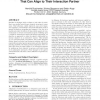701 search results - page 138 / 141 » Simulation for the Social Scientist |
ATAL
2010
Springer
13 years 9 months ago
2010
Springer
Speakers in dialogue tend to adapt to each other by starting to use similar lexical items, syntactic structures, or gestures. This behaviour, called alignment, may serve important...
ATAL
2010
Springer
13 years 9 months ago
2010
Springer
Establishing trust amongst agents is of central importance to the development of well-functioning multi-agent systems. For example, the anonymity of transactions on the Internet c...
BMCBI
2008
13 years 8 months ago
2008
Background: In gene expression analysis, statistical tests for differential gene expression provide lists of candidate genes having, individually, a sufficiently low p-value. Howe...
CORR
2010
Springer
13 years 8 months ago
2010
Springer
This paper presents a modeling process in order to produce a realistic simulation of crowds in the ancient Greek agora of Argos. This place was a social theater in which two kinds...
ENVSOFT
2007
13 years 8 months ago
2007
A multi-agent model of social and environmental complexity of deforestation was developed for the Caparo Forest Reserve, Venezuela. It includes three types of agents: settlers, go...

